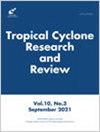Parameterization of boundary layer height based on helicity and its application in tropical cyclone numerical simulation
IF 4.1
4区 地球科学
Q3 METEOROLOGY & ATMOSPHERIC SCIENCES
引用次数: 0
Abstract
This study introduces a helicity-based parameterization method for determining the planetary boundary layer (PBL) height to better capture the complex dynamics of the tropical cyclone (TC) boundary layer (TCBL). By integrating this method into the Yonsei University (YSU) PBL scheme of the China Meteorological Administration (CMA) Mesoscale Model (CMA-MESO), the PBL height is dynamically determined using helicity as a proxy for frictional forcing in TCBL regions, while retaining the traditional bulk Richardson number (Rib) method in areas with weak or ambiguous helicity signals. Simulations of 28 Northwest Pacific TCs in 2022 demonstrate that this approach has negligible impact on track forecasts but substantially reduces the systematic underestimation of TC intensity compared to the traditional Rib-based method. The improvements in TC intensity predictions primarily originate from helicity-modulated PBL height adjustments, particularly the distinct elevation of PBL height within the eyewall region. Analysis of PBL tendencies indicates that elevated PBL height enhances low-level stratification instability through deepened heating within the PBL and expanded cooling at the PBL top. Meanwhile, the deepened frictional layer augments low-level convergence through strengthened agradient forcing induced by momentum dissipation. These thermodynamic and dynamic modifications foster convective concentration in the eyewall, where intensified diabatic heating interacts with high inertial stability to elevate heating efficiency, thus driving TC intensification. These findings highlight that the helicity-based parameterization method outperforms the Rib-based method by better determining the eyewall PBL height, whose deeper structure enhances low-level convergence and unstable stratification, providing a practical pathway to improve TC intensity prediction in numerical models.
基于螺旋度的边界层高度参数化及其在热带气旋数值模拟中的应用
为了更好地捕捉热带气旋边界层(TCBL)的复杂动力学,提出了一种基于螺旋度的行星边界层(PBL)高度参数化方法。将该方法与中国气象局(CMA)中尺度模式(CMA- meso)的延世大学(YSU) PBL方案相结合,利用螺旋度作为TCBL区域摩擦力的代表动态确定PBL高度,而在螺旋度信号较弱或不明确的地区保留传统的bulk Richardson number (Rib)方法。对2022年西北太平洋28个TC的模拟表明,该方法对路径预报的影响可以忽略不计,但与传统的基于肋的方法相比,大大减少了对TC强度的系统低估。对TC强度预测的改进主要来自于螺旋调制的PBL高度调整,特别是眼壁区域内PBL高度的明显升高。PBL趋势分析表明,PBL高度升高通过加深PBL内部加热和扩大PBL顶部冷却来增强低层分层不稳定性。同时,加深的摩擦层通过动量耗散引起的加强的梯度强迫增强了低层辐合。这些热力学和动力学的变化促进了眼壁的对流集中,在眼壁中,增强的非绝热加热与高惯性稳定性相互作用,提高了加热效率,从而推动了TC的增强。这些结果表明,基于螺旋度的参数化方法优于基于肋的方法,可以更好地确定眼壁PBL高度,其较深的结构增强了低层辐合和不稳定分层,为改进数值模型中的TC强度预测提供了实用途径。
本文章由计算机程序翻译,如有差异,请以英文原文为准。
求助全文
约1分钟内获得全文
求助全文
来源期刊

Tropical Cyclone Research and Review
METEOROLOGY & ATMOSPHERIC SCIENCES-
CiteScore
4.60
自引率
3.40%
发文量
184
审稿时长
30 weeks
期刊介绍:
Tropical Cyclone Research and Review is an international journal focusing on tropical cyclone monitoring, forecasting, and research as well as associated hydrological effects and disaster risk reduction. This journal is edited and published by the ESCAP/WMO Typhoon Committee (TC) and the Shanghai Typhoon Institute of the China Meteorology Administration (STI/CMA). Contributions from all tropical cyclone basins are welcome.
Scope of the journal includes:
• Reviews of tropical cyclones exhibiting unusual characteristics or behavior or resulting in disastrous impacts on Typhoon Committee Members and other regional WMO bodies
• Advances in applied and basic tropical cyclone research or technology to improve tropical cyclone forecasts and warnings
• Basic theoretical studies of tropical cyclones
• Event reports, compelling images, and topic review reports of tropical cyclones
• Impacts, risk assessments, and risk management techniques related to tropical cyclones
 求助内容:
求助内容: 应助结果提醒方式:
应助结果提醒方式:


